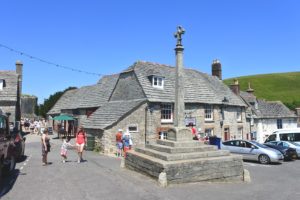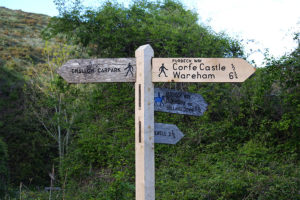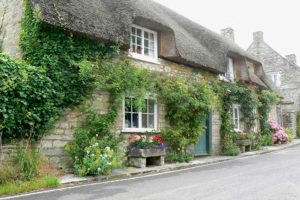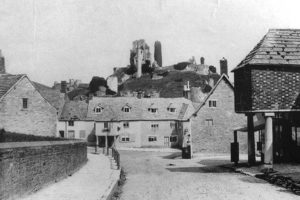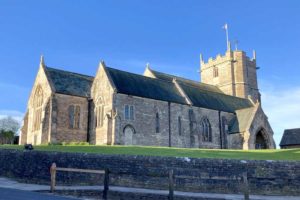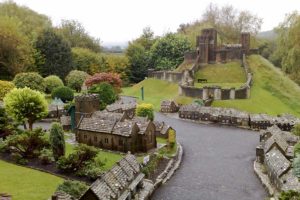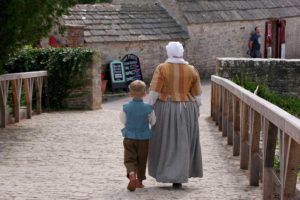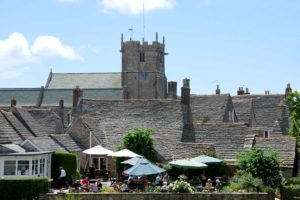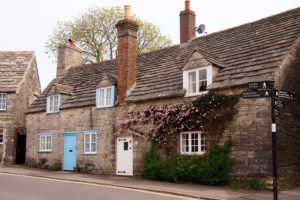CORFE, A VILLAGE AND A CASTLE

Corfe Castle is a Village and a Parish in Dorset whose skyline is dominated by the remains of Corfe Castle, which is the essence of the village, attracting visitors from all over the world.
The village is located halfway between Wareham and Swanage on the Isle of Purbeck in Dorset, the civil parish faces both the English Channel and Poole Harbour, which includes part of the sandy heathland to the north of the castle, and the Jurassic Coast to the South.
The dramatic ruins of Corfe Castle stand on a natural hill guarding the main route through the Purbeck Hills and the rest of Dorset. Nothing can pass in or out without going past the Castle.
CONSTRUCTED FROM THE LOCAL GREY PURBECK LIMESTONE
The village is constructed almost completely from the local grey Purbeck limestone and comprises two main streets, East Street and West Street, linked at their north end at the Square. Around the square with its cross commemorating Queen Victoria’s Diamond Jubilee of 1897 are a number of shops (including a post office), a church, three pubs and two hotels.

From the Square you can easily access the Castle, managed by the National Trust, a Model Village depicting how the castle looked before it was destroyed in the English Civil War, St Edwards Church, dedicated to St Edward the Martyr who was murdered in 978 and Corfe Castle Town Trust Museum.
You can also easily access the Corfe Castle to Swanage steam railway. The station has been restored and offers a relaxing way to visit nearby Swanage and Norden Halt (see How to Get Here for more information).
The village offers a number of pubs, restaurants and team rooms offering food and drinks. The village bakery is also situated in the Square. If you are looking for accommodation, Corfe offers a number of historic hotels, charming self-catering cottages, cosy bed and breakfasts and close by camping and caravan sites (see our Food and Drink and Accommodation pages for full details).
The main route through the village is East Street, which forms part of the A351 main road, taking traffic to Wareham in the north and Swanage in the south. West Street leads away from the square and offers the only parking in the village. Separating the two streets is an area of common land called “the Halves”, and to the south of the village is a much larger area of common land, which is great for walking and offers wonderful views of the Castle and surrounding area.
More Information and a bit of History
There is evidence around the village of a civilization that existed in 6000 BC; as well as Celtic habitation circa 1300 BC; and of course, the Romans circa AD 50. There is a legend which Tomas Hardy recorded concerning the disappearance of an entire Roman legion, with, of course, only its ghosts remaining; leading to the conclusion that a massive battle must have taken place between the Celts and the Romans which later resulted in the demise of the Celts. Early in the fifth century, after the Romans left, the Vikings and the Saxons occupied this area until AD 1090 when the Norman Conquest occurred. If you leave Corfe Castle and head towards Church Knowle, you may want to stop at Cromwell’s Battery, known locally as The Rings. This fortification, or Battery, was a ring and bailey castle. The higher, inner ring was a stronghold. The bailey was the storage and working area, surrounded by fences. The rings are believed to be the site of a siege castle built by King Stephen in 1139 AD in an unsuccessful attempt to regain control of Corfe Castle when he claimed the throne from the House of Blois and Civil War ensued.
Corfe Castle has dominated the skyline of the Isle of Purbeck for the past thousand years. From its inception, it was designed to protect from invasion from the coast, with its passage through the Purbeck Hills from Swanage to Wareham. Corfe Castle was a ring and bailey castle built in early Norman times during the era of William the Conqueror. Prior to the Normans, there was a fortification on this site, and there may have been a Roman military presence here as well. William the Conqueror rebuilt the fortification with stone to insure its durability for use as a royal fortress. (Purbeck Stone is considered the finest limestone in England). In the 13th century King John improved the castle defences and also erected a hall, a chapel and some domestic buildings. Following that, Henry III added additional walls, towers and gatehouses.
Ironically, although fortified to be impregnable, the skeletal ruins that stand today were destroyed from within. This fascinating ruin, which attracts millions of visitors, was caused by a “turncoat” during the civil war, who gave entry into the castle from the inside, thereby allowing Cromwell’s army to enter the castle to destroy everything in their path. Today, the castle remains reveal evidence of a stronghold that predated the Norman Conquest, and the site of the assassination of Edward the Martyr in March 978. The surviving structure of the later castle dates to the 11th century.
Cromwell’s army fought the most remarkable Lady Bankes, a Royalist, who cared for the castle while her husband, Sir John was called away by Charles I, earning her the name “Brave Dame Mary” as well as the respect of the Parliamentary commander; who was so impressed with her courage that he allowed her to leave the castle with her garrison and the keys to the castle once the Roundheads finally persuaded her to surrender. The Bankes family preserved the keys at their family home of Kingston Lacy, which is also protected by the National Trust and open to the public (link).
The National Trust visitor’s centre has more information about the Castle and the general area, as well as a shop and tearoom in the village. The Corfe Model Village is a fascinating look into the castle and village prior to its siege, built to a 1/20 scale model by a local individual. There is also the Church of St. Edward in the village, which has alabaster reredos inset with carvings in white marble designed by George Edmund Street R.A., a famous Victorian architect. While in the village, you may also enjoy a visit to the smallest town hall in England, which is used as a museum and admission is free. The museum has numerous artefacts on display, including dinosaur footprints and “local items of a bygone era”.
Corfe Castle is will also be familiar to those who have read Enid Blyton’s Famous Five Books, as it is accepted to be the model for Kirren Castle in the children’s series.
Where exactly is Corfe Castle?
Corfe Castle is located in Dorset along the A351 between Wareham and Swanage. The nearest populated areas include Studland to the east and Wareham to the north and Swanage to the south. More information can be found on the How to Get Here page.
About Corfe Castle
The castle itself stands above the village and dates back in some form to the 10th century. It was the site of the murder of Edward the Martyr in 978. During the English Civil War it was a Royalist stronghold and was besieged twice, in 1643 and again in 1646. It is currently owned by the National Trust and is open to the public (see the main Corfe Castle page for opening times, prices and more information).

